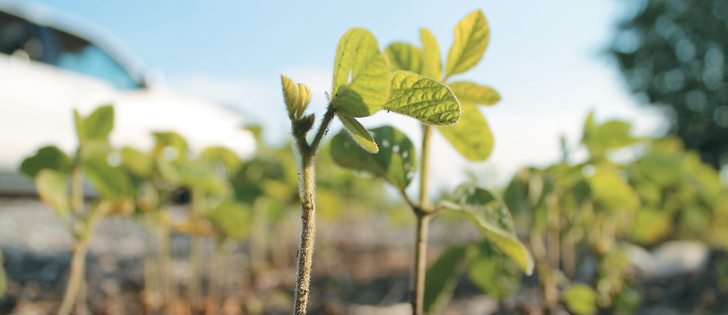Last season’s test plots at Indian Head, Sask., were damaged by an early September frost
WHITE CITY, Sask. — Data is now in from the first year of a soybean research project at the Indian Head Agricultural Research Foundation that is providing information specific to Saskatchewan growers.
The province’s farmers have expanded their soybean acreage the past few years but are relying largely on information from the United States and other provinces.
Long-term soybean studies at the research foundation are intended to remedy that. They are funded by both the public and private sectors.
Research manager Chris Holzapfel said industry-funded variety trials on the research farm increased from one in 2012 to six in 2013 and 11 last year, which accounts for 20 percent of the foundation’s small plot work.
Read Also

VIDEO: Claas Axion 9.450 tractor wins ‘Tractor of the Year’ at Agritechnica 2025
On opening day of Agritechnica 2025, Claas’ Axion 9.450 Terra Trac tractor was awarded ‘Tractor of the Year’ for 2026 in the HighPower category.
Early frost on Sept. 9-10 affected most of the plots, he told farmers at an IHARF seminar.
“None of the pods had started to turn colour,” he said. “
“They really could have benefited from an extra couple of weeks.”
He estimated that 20 to 30 percent of yield potential was lost because of the frost. The seeds were small and yields averaged slightly more than 20 bushels per acre.
Seeding date trials compared three soybean varieties with field peas, fababeans and canola. The crops were planted on three dates beginning as early in May as possible and ending in early June, Holzapfel said.
The earliest date was May 17, and the soybeans yielded 20 bu. per acre compared to 40 to 45 bu. per acre for canola, 20 bu. for field peas and 90 bu. for fababeans.
The later seeded crops did not fare as well.
Holzapfel said the third week in May seems to be the best seeding date.
Another trial examined the use of granular inoculant.
All the seed was treated and different rates of granular inoculant applied.
“We got a very strong response here,” he said.
Yields climbed steadily up to two times the label rate for the inoculant, and Holzapfel recommended using at least that much.
Half of the plots were also treated with Headline fungicide, which did not affect yield.
He said a fertility trial produced the most surprising results. Side banded starter nitrogen of 50 pounds per acre caused a substantial yield boost: from 17 bu. per acre without it to 24 bu. per acre with it.
Holzapfel said the typical school of thought is soybeans don’t need nitrogen.
“After last year I guess I have more questions than answers,” he said.
One of those questions is whether the nitrogen replaced adequate inoculation.
The trial also included side banded and seed placed phosphorus from zero to 36 lb. per acre.
“Soybeans are considered to be a crop that can handle high rates of seed placed fertilizer, but we weren’t able to pick up any effects whatsoever of seed placed versus side band at the rates that we’ve chosen,” he said.
There was a strong response to phosphorus as yields climbed by 35 percent.
A seeding rate and depth trial examined rates of 61,000 to 340,000 seeds per acre at a shallow depth of .75 inches and 1.5 inches.
“Depth did not affect emergence, but rate certainly did,” said Holzapfel.
“We had a strong linear increase all the way up to the highest rate that we put down.”
Stressful weather conditions might have played a role, and he said not everyone could afford to plant the highest rates.
He also said the plants yielded significantly larger seeds when seeded at the shallower depth. That said, all the seeds were small because of the frost.
A row spacing trial from 10 to 24 inches at seeding rates of 162,000 and 243,000 seed per acre saw a slight gradual decline in plant density as row spaces widened.
Holzapfel said that isn’t unusual, but he was surprised by yields.
“We usually see a slight decline in yields with wider spacing,” he said.
“In the case of the soybeans, they really kept climbing all the way up to 24-inch row spacing.”
It could be because soybeans are well adapted to row cropping or it could have something to do with inoculation, he suggested.
At this point, he recommends growers choose early maturing varieties, seed 220,000 to 240,000 seeds per acre no more than one inch deep and between May 15 and 30 on a warm day.
Row spacing can be variable, but he said that affects how much inoculant is needed.
“The narrower your row spacing, you’re going to want to use a higher rate of inoculant,” he said, recommending at least two times the label rate for granular product.
Soybeans thrive on phosphorus and will use it, he added.
Contact karen.briere@producer.com
















